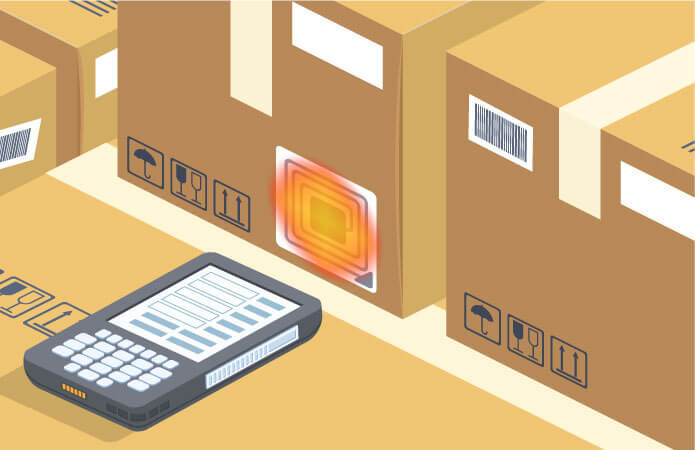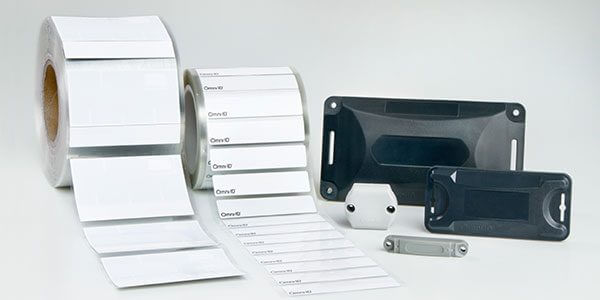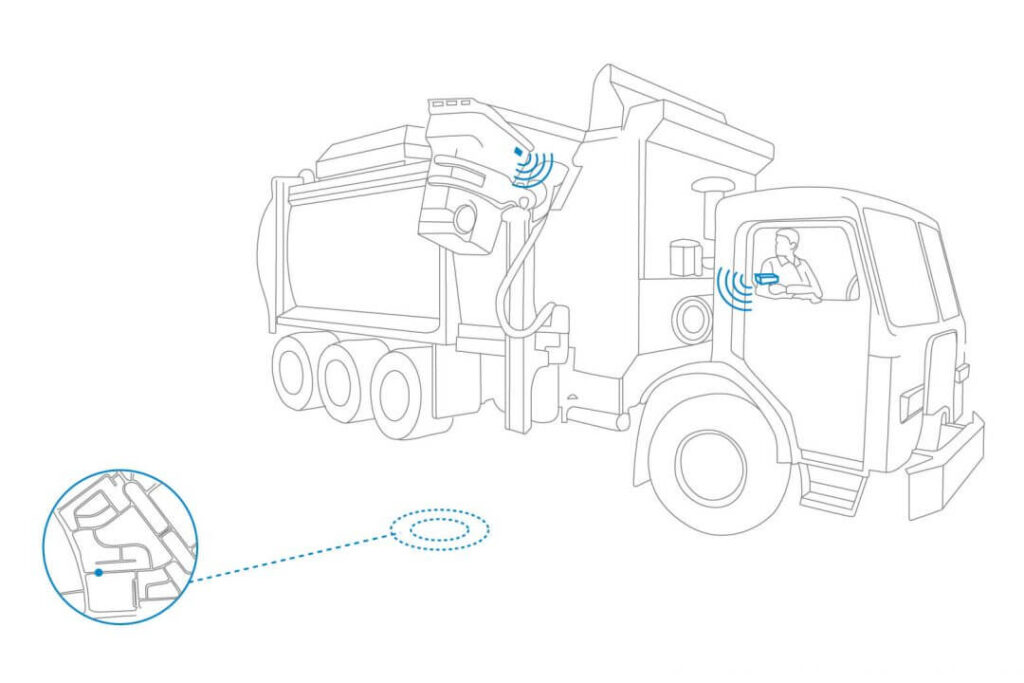Contents
What is RFID?
RFID stands for radio-frequency identification, and is a vital part of modern tracking, location, and identification technologies. It uses electromagnetic fields to identify and track RFID tags. These tags are small and can be attached to people, machines, electronic devices, vehicles, or any other physical object. RFID tags act as intelligent barcodes that can be scanned to identify and obtain information about the RFID tag.
Brief history of RFID
In 1973, Mario Cardullo patented the first technological ancestor of modern RFID. Cardullo made the first passive radio transponder with built-in memory. His device was ‘passive,’ meaning it was powered by the interrogating signal it received. The transponder device had a memory of 16 bits and was used as a toll device.
Before Cardullo made his radio transponder, he pitched a business plan outlining his goals for the device he was attempting to create. In this business plan, he explained how he can make a transponder device for use in transportation, banking, security, and medicine. The technology matured over the following decade, and in 1983 the first patent for modern RFID technology was granted to Charles Walton, an American inventor from Maryland.
How does RFID work?
Tracking objects using RFID technology involves a radio transponder, radio receiver, and radio transmitter. An RFID tag needs to be triggered by a RFID reader device in order to send out digital data about itself (usually an identification number). According to the U.S. Food & Drug Administration RFID is a wireless system comprising two primary components: tags and readers.
RFID readers are devices with one or more antennas capable of emitting radio waves to RFID tags, and receiving signals back from RFID tags. The radio signals received by RFID readers from RFID tags contain identification and other information directly related to the object with the RFID tag.
RFID readers are handheld devices that can also be mounted to posts or overhead to scan RFID tags to extract information. RFID readers can also be built into building architectures such as walls, rooms, desks, cabinets, etc… Modern RFID tags can store a variety of information ranging from a single serial number to several pages of data.

What are the types of RFID?
There are several types of RFID in use around the world today. Each type is either active (battery powered), passive (no batter), or semi-passive (battery assisted).
The active RFID tag is a type of miniature transmitter that is constantly sending out a radio signal. It contains an internal power source, usually a small battery, that is long-lasting. Some tags can go as long as a few years before they need recharging or battery replacement.
Passive RFID labels or RFID inlays are more like a simple antenna with an RFID chip. When the passive tag comes within the range of an RFID reader that is transmitting a radio signal, this signal energizes the passive RFID tag’s antenna. Once activated, it sends out a reply including its unique ID number that is picked up by the reader.
The active tag also sends its signal out to an active RFID reader but does so using its internal power source.
What is an RFID tag (smart label)?
RFID tags, also called RFID chips, are small devices used for radio frequency identification. They send radio waves to RFID readers which then send the information within the radio waves to a RFID computer program capable of translating that information to something useful to humans, such as an identification number or other information. RFID tags are often used to track merchandise, automobiles, pets, hospital patients, and any other objects or things an RFID tag can be attached to.

What do RFID tags do?
RFID tags work by using a microchip and antenna to transmit and receive information. Every RFID tag can be programmed with any relevant information desired by its programmer. RFID tags can either be passive or active.
Passive RFID tags are powered by the energy present in the radio frequency sent to them by RFID readers, and active RFID tags have their own onboard batteries to assist them with sending information to RFID readers. When passive RFID tags are scanned by a RFID reader they receive enough power to activate their computer chip, and send a packet of information back to the RFID reader through its antenna. Active RFID tags automatically send out signals on a regular basis or when a RFID scanner is present.
What are the types of RFID tags?
RFID tags operate using a wide variety of frequency ranges, each with unique characteristics that make them more suitable for some situations and not for others. These frequencies are: low-frequency (30 KHz to 300 KHz), high-frequency (3 MHz to 30 MHz), and ultra-high-frequency (300 MHz to 3 GHz).

Low-frequency RFID tags
Low-frequency RFID tags operate in the radio frequency range between 30 KHz to 300 KHz. They have the shortest range and slowest read rates when compared to high-frequency and ultra-high-frequency RFID tags.
Low-frequency RFID tags excel at avoiding interference from metals and liquids. This is possible because low-frequency RFID tags use longer wavelengths that make them more resistant to interference. The interference resistance characteristics of low-frequency RFID tags makes them best suited for when an RFID tag needs to be attached to metal objects, such as beer kegs or cars.
High-frequency RFID tags
High-frequency RFID tags operate in the radio frequency range between 3 MHz to 30 MHz. They have more memory and longer ranges compared to low-frequency RFID tags. This makes them more practical for use when interference is not an issue, such as book inventory management in a library or wrist bands at music festivals or theme parks. High frequency RFID tags are the most versatile type of RFID tag when compared to low-frequency and ultra-high-frequency RFID tags.
Near field communication (NFC) tags

A subcategory of high-frequency RFID tags commonly used are near field communication (NFC) tags. NFC tags operate at 13.56 MHz, making them a type of high-frequency RFID tag with a much shorter read range compared to other high-frequency RFID tags. NFC tags require an NFC reader to be within centimeters of the NFC tag to be read, and must be read by readers one at a time.
NFC tags can also store larger amounts of information compared to other high-frequency RFID tags, and support two way communications making them ideal for storing and communicating large amounts of information. The characteristics of NFC tags make them ideal for secure contactless payments.
Ultra-high-frequency RFID tags.
Ultra-high frequency RFID tags operate in the radio frequency range between 300 MHz to 3GHz. They have less read range and data rates compared to high-frequency RFID tags, but more than low-frequency RFID tags. What makes ultra-high RFID tags unique is their ability to be produced at a lower cost than other types of RFID tags. This makes them ideal for use in supply chains where large numbers of inventories need to be identified simultaneously.
Where are RFID tags used?
RFID identification numbers are usually used by businesses seeking to track their inventories but are used for many applications other than inventory tracking. RFID technology is used in situations requiring individual objects to be identified quickly and efficiently. RFID tags are commonly used for, but not limited to, the following purposes:
- Supply chain management
- Inventory tracking
- Textile tracking
- Returnable transit item tracking
- Access control
- Tolls
- Animal tracking
- Jewellry tracking
- Pipe and spool tracking
- Marketing campaigns
- Real-time location systems (RTLS)
- Race timing
- Pharmaceutical tracking
- Information technology asset tracking
- File tracking
- Event & attendee tracking
- Hospital patient tracking
- Tool tracking
- Material management
- Library book tracking
What is an RFID tracker?
RFID trackers are RFID devices made specifically for tracking purposes. They are made to automate the management and location of physical assets in a cost-effective manner. RFID trackers typically contain information related to names, condition, amounts, and location.
Benefits of RFID trackers
Benefits offered by RFID trackers include: ability to track multiple assets at once, not requiring human intervention, real-time data collection, increase asset visibility, locating misplaced or lost assets, and achieving inventory counts with a high degree of accuracy.
How is RFID used for tracking?
The most common type of RFID used for tracking purposes are passive RFID tags. All passive RFID tags are able to be scanned by an RFID reader at any point along their supply chain or consumer life cycles. Passive RFID tags are used more than active RFID tags for tracking because they do not need an onboard battery for their operation. Passive RFID tags are able to function in response to RFID readers, making them more cost effective than active RFID tags because batteries are not included in their cost. If you’re asking how much are RFID chips, passive RFID tags cost between $0.5 to $0.5 per tag, while active RFID tags cost between $5 to $15 per tag.
Can RFID tags be tracked?
Yes, RFID tags can be tracked. They can be tracked automatically using active RFID tags or manually using passive RFID tags. To be tracked RFID tags provide data related to where they have been and where they currently are. How RFID tags are tracked is up to the RFID programmer and the entities receiving information packets from RFID tags of interest.
How far can RFID be tracked?
RFID tags can be tracked at different ranges depending on if they are passive or active. Active RFID tags have an onboard battery which helps them send their signals over longer distances to RFID readers. Passive RFID tags are limited with how far they can send signals to RFID readers because their signal range is limited by the power supplied by the RFID reader itself. Passive RFID tags have a range of about 1-5 meters, and active RFID tags have a range of up to 30+ meters. The extra tracking range of active RFID tags makes them ideal for scaling location tracking over large areas.
How to track an RFID location?
To track the location on RFID tags there must be RFID readers at locations where the location of RFID tags is desired to be known. When scanned, the location of an RFID tag can be logged in a computer program to be referenced again at a later date. RFID tags can be integrated into devices or clothing to have their motions actively tracked.
Tracking motion using RFID tags is made more accurate by adding additional RFID tags on the same object to calculate changes in motion or shape of an object based on signal timing differences between RFID tags.
Tracking active RFID tags is easier than tracking passive RFID tags, because RFID readers do not need to be close to active RFID tags to interact with them. Significantly larger areas containing active RFID tags can be tracked compared to passive RFID tags.
What are RFID readers?
RFID readers are the device making RFID systems possible. They are also sometimes referred to as ‘interrogators’ and are the devices transmitting and receiving radio frequencies to and from RFID tags.
RFID readers can vary in their functional frequency ranges, mobility characteristics, connectivity options, external device capabilities, power options, processing power, and antenna ports. RFID readers are the most expensive part of RFID systems. They can range in price between $400 and $3000 depending on desired features.
What are the types of RFID readers?
There are two types of RFID readers: fixed and mobile. Fixed RFID readers remain stationary and are affixed onto a specific location such as a well, desk, or other stationary location. Mobile RFID readers are handheld devices that can either be connected to an external computer, or have an onboard computer for displaying RFID tag information to users. RFID readers with an onboard computer are referred to as Mobile Computing Devices, and RFID readers that need to be connected with an external computer are called Sleds.
What are RFID badges?
RFID badges are RFID tags made specifically for security purposes. They are typically used to correctly identify relevant personnel at a certain location, such as a student at a school or an employee in the workplace. RFID badges can grant or deny access to certain areas, be used to check into and out of locations, and for identity verification purposes.

Unique identities of RFID badges
A unique identity is programmed into each RFID badge by the RFID badge supplier. This identity is immutable after its creation to make it more secure and proprietary for RFID systems. Although RFID badges can also be made to have mutable identification numbers, it is not common practice.
How do RFID badges work?
RFID badges work the same as RFID tags. They require RFID readers to scan them for information about the RFID badge. RFID badges are more robust and longer lasting than other information storage and identification systems, such as magnetic strips or barcodes. RFID badges are contactless, which is their primary weakness.
RFID readers may scan RFID badges from a distance which introduces the ability for malicious entities to gain access to functions and information controlled by an RFID tag. The unwarranted scanning of RFID tags and RFID badges is known as ‘RFID skimming’ and is perceived to be the main weakness of RFID technology for security and privacy concerns.
RFID skimming can be overcome by requiring additional security measures to be satisfied before information can be sent such as biometric confirmation or a PIN code. Another way to protect against RFID skimming is to store RFID badges or RFID tags inside of another object capable of blocking radio frequencies from entering or leaving the object.
Is RFID harmful to humans?
RFID is generally accepted to be safe for humans. Most harm RFID technology causes to humans are related to the security concerns generated by RFID skimming, and by privacy violations / concerns. RFID technology is made for identifying, tracking, and sending information using radio frequencies. The radio frequencies used for RFID technology are regarded as safe, and not harmful to humans or animals.
The radio frequencies used by RFID systems do not possess enough energy to harm the human body when traditionally used for tasks such as animal tracking, inventory management, product tracking, identification, etc.
Thermal effects
The biological effects of radio frequencies are often referred to as ‘thermal effects’, according to the Federal Communications Commission. RFID technology may cause damage to biological tissues when exposure to very high levels of radio frequency radiation occurs.
In typical use cases for RFID technology there are very low amounts of concentrated radio frequency radiation which makes the thermal effects of radio frequency radiation insignificant.
Non-thermal effects
Harmful effects to the human body beyond thermal effects remain unproven and ambiguous. Scientific studies showing any negative ‘non-thermal effects’ of radio frequencies have not been able to be replicated.
Despite the strong evidence supporting the safety of radio frequencies, many scientists, citizens, and organizations agree that more research needs to be done to further understand how radio frequencies interact with the human body.
What are the safety concerns related to RFID implantation into the human body?
There are some health safety concerns regarding the use of RFID tags implanted inside of the human body. RFID tags are small devices that may move around in the body when implanted to undesirable places that may cause health problems.
Other risks of implanted RFID tags include electrical hazards, infections, adverse tissue reactions, and incompatibility with medical devices such as MRI machines. Researchers also believe there may be a risk of unforeseen pharmaceutical reactions and electrosurgical and electromagnetic interferences with medical devices caused by RFID tags implanted within the human body.
Implanting RFID tags into the human body is often used as a last resort for high-risk patients suffering from diseases that are seeking to voluntarily implant an RFID chip into their body. Common reasons people choose to implant RFID tags into their body are to monitor cardiovascular disease and manage diabetes.
Are there RFID safety regulations?
Organizations and governments around the world are continuing to monitor the latest scientific studies regarding potential harmful effects of RFID on the human body, and constantly challenge their validity and determine if any safety regulations need to be changed
Conclusion
Since its first patent in 1973, RFID has been used in various situations and sectors. It is vital for identification and tracking. There are several types of RFID in use around the world today. Each type is either active (battery powered), passive (no batter), or semi-passive (battery assisted). The radio frequencies used for RFID technology are regarded as safe, and not harmful to humans or animals. The radio frequencies used by RFID systems do not possess enough energy to harm the body.
If you’re having doubts about using RFID systems in your facility considering how much are RFID chips compared to their benefits to your processes, we can further discuss our solutions. Drop us a line and we’ll get back to your concerns immediately.




